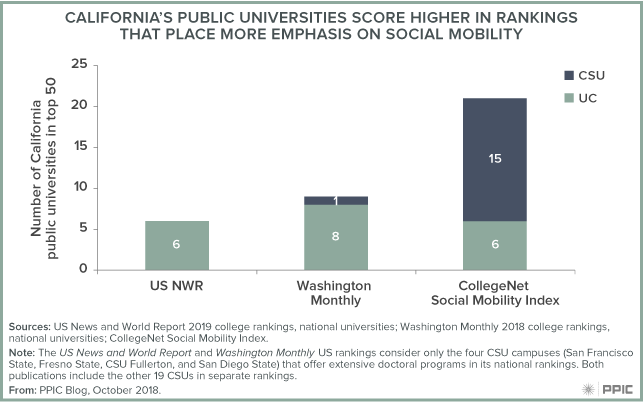As high school seniors decide where to apply, numerous websites, magazines, and organizations are releasing lists of the “best colleges.” These rankings try to evaluate a college’s quality or highlight a particular factor, such as best value. Most rankings use similar data sources and variables, but each weighs factors differently in order to define and evaluate quality. Popular categories include student outcomes (graduation rate, earnings after college), measures of institutional quality (faculty quality, monetary value of resources for students), and affordability (net cost, institutional aid). Improving a college’s rank generally involves doing better in one or more of those areas relative to other institutions.
Recently, many rankings have started to consider social mobility—a school’s ability to move students up the ladder of economic opportunity. But the importance of social mobility in overall rankings varies widely. Just this year, US News World Report—a longtime leader in college rankings—removed acceptance rates from its methodology and instead factored in graduation rates for students who receive Pell Grants (these students are from the lowest-income families in the nation). Even so, the US News and World Report rankings do not give much weight to that measure. In contrast, Washington Monthly, another well publicized ranking, bases one third of its ranking scores on social mobility, including new data on graduation rate gaps between students who receive Pell Grants and those who do not. At the other end of the spectrum, the relatively new CollegeNet Social Mobility Index (established in 2014) focuses exclusively on elements of social mobility.
Research by the Equality of Opportunity Project shows that California’s public colleges do relatively well in promoting social mobility, particularly in moving students from the lowest to the highest quartile of income. The figure below shows the number of California’s public universities the top 50 according to each of three rankings; the greater the importance of social mobility, the higher California public universities rank relative to both private and public schools in other states.

Colleges pay attention to rankings, and highly rated schools publicize their ranks and use them in recruitment literature. A closer link between higher rankings and improved social mobility can be a win for California, its colleges, and its students.





